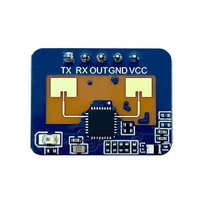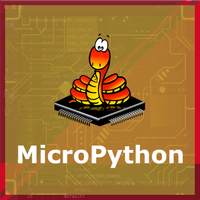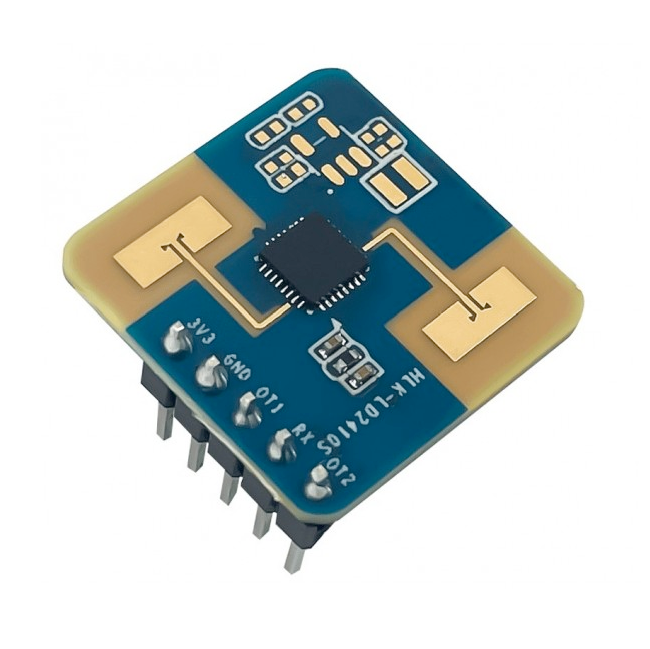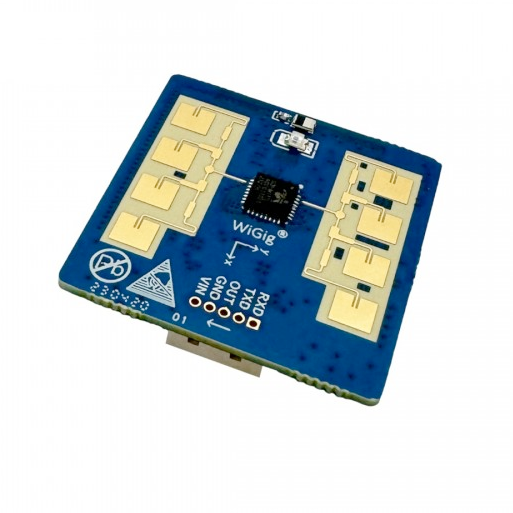ESP32 LD2410C Human Presence Sensor Pinout, Wiring, ESP32 and more
Overview
The LD2410C is a millimeter-wave radar sensor for human presence detection, supporting both stationary and moving target detection. It uses UART communication and is ideal for smart home automation systems.
About LD2410C Human Presence Sensor
The LD2410C is a compact 24GHz mmWave radar sensor designed for human presence detection. It utilizes FMCW (Frequency Modulated Continuous Wave) technology to detect both moving and stationary human targets within a range of up to 6 meters. The sensor offers a digital OUT pin for simple presence detection and UART communication for advanced configurations. Unlike the LD2410 and LD2410B, which use 1.27mm pin spacing, the LD2410C features a standard 2.54mm pin spacing for easier breadboard and header integration. This makes it more convenient to prototype with development boards like the ESP32. For more information on the LD2410 series, see LD2410.
Where to Buy LD2410C Human Presence Sensor



Prices are subject to change. We earn from qualifying purchases as an Amazon Associate.
LD2410C Datasheet and Technical Specifications
LD2410C Pinout Diagram
The VCC pin is used to supply power to the sensor, and it typically requires 3.3V or 5V (refer to the datasheet for specific voltage requirements). The GND pin is the ground connection and must be connected to the ground of your ESP32.
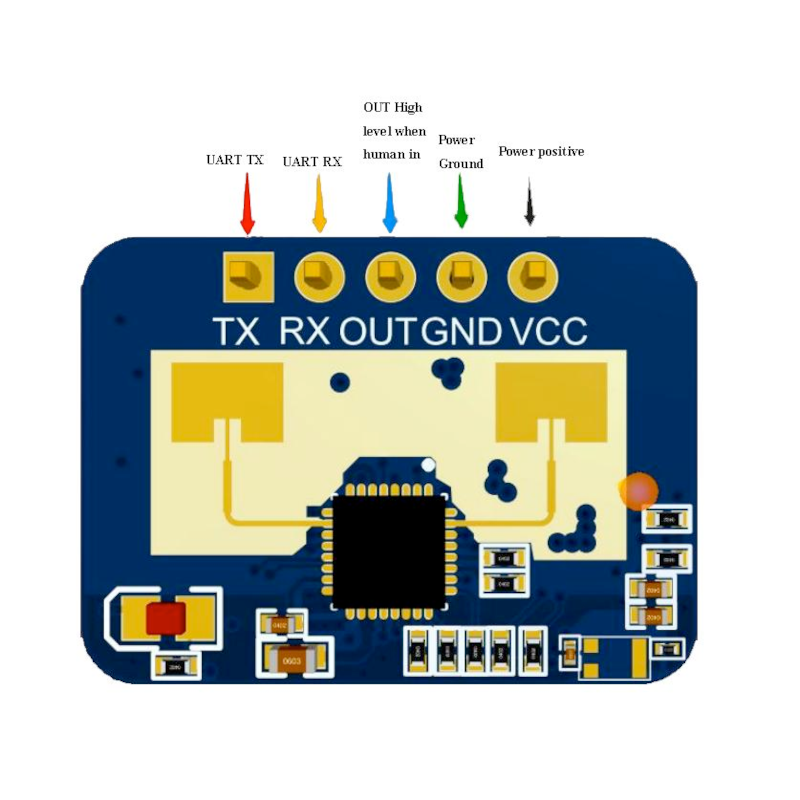
The LD2410C module features a simplified and breadboard-friendly design with standard 2.54mm pin spacing. It provides all necessary connections for both UART-based communication and optional digital output, while supporting a wide voltage input range. Pin definitions include:
VCC– Power input pin. Accepts 5V to 12V DC (5V is recommended for ESP32 compatibility). Supplying correct voltage ensures stable radar operation.GND– Ground reference pin. Must be connected to the same ground as the ESP32 or host system for reliable signal integrity.TX– UART transmit pin. Sends serial output from the LD2410C. Connect this pin to the ESP32’s UART RX (e.g., GPIO16).RX– UART receive pin. Receives configuration or control commands. Connect this pin to the ESP32’s UART TX (e.g., GPIO17).OUT– Digital presence output. Goes HIGH when presence is detected. Operates at 3.3V logic level, suitable for direct input to ESP32 GPIOs. Optional use for hardware interrupt or simple presence-based logic control.
Note: The LD2410C drops the compact 1.27mm pitch seen in earlier versions and replaces it with 2.54mm headers for easier prototyping and integration with development boards.
LD2410C Wiring with ESP32
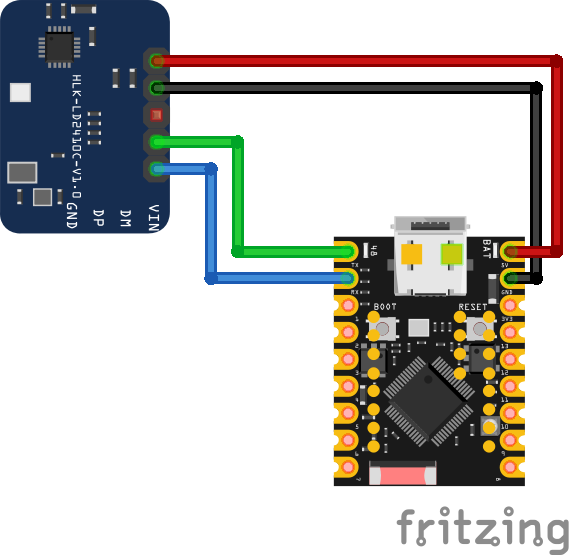
To connect the LD2410C radar sensor module to an ESP32 via UART, follow the connections below. This setup uses ESP32's UART2 interface (commonly GPIO16 and GPIO17). Make sure the sensor receives a stable 5V supply and that your ground lines are securely tied:
VCC(red wire) → 5V on ESP32 (or external 5V source if needed for higher power stability).GND(black wire) → GND on ESP32. Ensure this is securely connected to prevent floating signals.TX(green wire) → GPIO16 on ESP32. This serves as the ESP32’s receive pin for incoming data.RX(blue wire) → GPIO17 on ESP32. This acts as the transmit pin from ESP32 to the sensor.OUT(yellow wire, optional) → GPIO18 on ESP32 if you wish to use the digital HIGH signal as an external trigger or presence flag.
Ensure UART2 is selected in your firmware configuration, and that the baud rate matches what’s defined in the sensor’s initialization (typically 256000). The OUT pin is not required for UART operation but provides a useful hardware-level presence indicator.
LD2410C Troubleshooting Guide
Common Issues
🚫 No Data Received
Issue: The ESP32 receives no data from the sensor.
Ensure correct wiring: swap TX and RX if needed, and confirm baud rate is set to 256000. Verify power is supplied at 5V.
❌ Presence Not Detected
Issue: The sensor does not detect presence even when someone is in range.
Check detection gates and sensitivity settings using the LD2410C configuration tool. Ensure ESPHome configuration matches sensor wiring.
⚠️ Intermittent Detection
Issue: Sensor intermittently detects presence or fails to maintain detection.
Adjust gate sensitivity or reposition sensor to minimize obstructions. Use the configuration tool for fine-tuning detection zones.
🔌 UART Initialization Fails
Issue: UART component in ESPHome reports failure to initialize.
Verify UART pins are correct, baud rate is 256000, and no other component is using the same UART bus.
Debugging Tips
🔍 Serial Monitor
Use the Serial Monitor to check for error messages and verify the sensor's output. Add debug prints in your code to track the sensor's state.
⚡ Voltage Checks
Use a multimeter to verify voltage levels and check for continuity in your connections. Ensure the power supply is stable and within the sensor's requirements.
Additional Resources
LD2410C Code Examples
Arduino Example
#if defined(ARDUINO_SAMD_NANO_33_IOT) || defined(ARDUINO_AVR_LEONARDO)
//ARDUINO_SAMD_NANO_33_IOT RX_PIN is D1, TX_PIN is D0
//ARDUINO_AVR_LEONARDO RX_PIN(RXI) is D0, TX_PIN(TXO) is D1
#define sensorSerial Serial1
#elif defined(ARDUINO_XIAO_ESP32C3) || defined(ARDUINO_XIAO_ESP32C6)
//RX_PIN is D7, TX_PIN is D6
#define sensorSerial Serial0
#elif defined(ESP32)
//Other ESP32 device - choose available GPIO pins
#define sensorSerial Serial1
#if defined(ARDUINO_ESP32S3_DEV)
#define RX_PIN 18
#define TX_PIN 17
#else
#define RX_PIN 16
#define TX_PIN 17
#endif
#else
#error "This sketch only works on ESP32, Arduino Nano 33IoT, and Arduino Leonardo (Pro-Micro)"
#endif
// User defines
// #define DEBUG_MODE
#define ENHANCED_MODE
#define SERIAL_BAUD_RATE 115200
//Change the communication baud rate here, if necessary
//#define LD2410_BAUD_RATE 256000
#include "MyLD2410.h"
#ifdef DEBUG_MODE
MyLD2410 sensor(sensorSerial, true);
#else
MyLD2410 sensor(sensorSerial);
#endif
unsigned long nextPrint = 0, printEvery = 1000; // print every second
void printValue(const byte &val) {
Serial.print(' ');
Serial.print(val);
}
void printData() {
Serial.print(sensor.statusString());
if (sensor.presenceDetected()) {
Serial.print(", distance: ");
Serial.print(sensor.detectedDistance());
Serial.print("cm");
}
Serial.println();
if (sensor.movingTargetDetected()) {
Serial.print(" MOVING = ");
Serial.print(sensor.movingTargetSignal());
Serial.print("@");
Serial.print(sensor.movingTargetDistance());
Serial.print("cm ");
if (sensor.inEnhancedMode()) {
Serial.print("
signals->[");
sensor.getMovingSignals().forEach(printValue);
Serial.print(" ] thresholds:[");
sensor.getMovingThresholds().forEach(printValue);
Serial.print(" ]");
}
Serial.println();
}
if (sensor.stationaryTargetDetected()) {
Serial.print(" STATIONARY= ");
Serial.print(sensor.stationaryTargetSignal());
Serial.print("@");
Serial.print(sensor.stationaryTargetDistance());
Serial.print("cm ");
if (sensor.inEnhancedMode()) {
Serial.print("
signals->[");
sensor.getStationarySignals().forEach(printValue);
Serial.print(" ] thresholds:[");
sensor.getStationaryThresholds().forEach(printValue);
Serial.print(" ]");
}
Serial.println();
}
if (sensor.inEnhancedMode() && (sensor.getFirmwareMajor() > 1)) {
Serial.print("Light level: ");
Serial.println(sensor.getLightLevel());
Serial.print("Output level: ");
Serial.println((sensor.getOutLevel()) ? "HIGH" : "LOW");
}
Serial.println();
}
void setup() {
Serial.begin(SERIAL_BAUD_RATE);
#if defined(ARDUINO_XIAO_ESP32C3) || defined(ARDUINO_XIAO_ESP32C6) || defined(ARDUINO_SAMD_NANO_33_IOT) || defined(ARDUINO_AVR_LEONARDO)
sensorSerial.begin(LD2410_BAUD_RATE);
#else
sensorSerial.begin(LD2410_BAUD_RATE, SERIAL_8N1, RX_PIN, TX_PIN);
#endif
delay(2000);
Serial.println(FILE);
if (!sensor.begin()) {
Serial.println("Failed to communicate with the sensor.");
while (true) {}
}
#ifdef ENHANCED_MODE
sensor.enhancedMode();
#else
sensor.enhancedMode(false);
#endif
delay(nextPrint);
}
void loop() {
if ((sensor.check() == MyLD2410::Response::DATA) && (millis() > nextPrint)) {
nextPrint = millis() + printEvery;
printData();
}
}The LD2410C is fully compatible with the same Arduino code used for the LD2410 sensor. You can refer to the MyLD2410 library and use identical UART wiring and commands. No code changes are required aside from ensuring proper voltage levels and UART configuration. See LD2410 Arduino Example for implementation details.
ESPHome Example
esphome:
name: ld2410_sensor
platform: ESP32
board: esp32dev
logger:
uart:
id: uart_bus
tx_pin: GPIO17
rx_pin: GPIO16
baud_rate: 256000
ld2410:
uart_id: uart_bus
binary_sensor:
- platform: ld2410
has_target:
name: "Presence Detected"
has_moving_target:
name: "Moving Target Detected"
has_still_target:
name: "Still Target Detected"
sensor:
- platform: ld2410
moving_distance:
name: "Moving Distance"
still_distance:
name: "Still Distance"
moving_energy:
name: "Moving Energy"
still_energy:
name: "Still Energy"
detection_distance:
name: "Detection Distance"
text_sensor:
- platform: ld2410
version:
name: "LD2410 Firmware Version"
mac_address:
name: "LD2410 MAC Address"ESPHome configurations for the LD2410C are identical to those used for the LD2410. You can use the same UART settings, component definitions, and binary/sensor blocks. Refer to the LD2410 ESPHome Integration for YAML examples.
PlatformIO Example
platformio.ini
[env:esp32dev]
platform = espressif32
board = esp32dev
framework = arduino
lib_deps =
iavorvel/MyLD2410@^1.0.2
monitor_speed = 115200PlatformIO Example Code
#include <MyLD2410.h>
MyLD2410 radar;
void setup() {
Serial.begin(115200);
Serial2.begin(256000, SERIAL_8N1, 16, 17); // RX=16, TX=17
if (!radar.begin(&Serial2)) {
Serial.println("Failed to initialize LD2410 sensor");
while (true) {}
}
Serial.println("LD2410 initialized successfully");
}
void loop() {
radar.read();
if (radar.presenceDetected()) {
Serial.println("Presence detected");
Serial.print("Still distance: ");
Serial.println(radar.stillDistance());
Serial.print("Moving distance: ");
Serial.println(radar.movingDistance());
} else {
Serial.println("No presence");
}
delay(1000);
}The LD2410C is fully compatible with the same MyLD2410 PlatformIO library and example code used for the LD2410. You can use identical UART wiring (TX=17, RX=16) and no code changes are necessary to support LD2410C functionality. Refer to the LD2410 PlatformIO Example for a complete implementation using the PlatformIO environment.
MicroPython Example
from machine import UART
import time
# Initialize UART2: TX=17, RX=16, baud rate 256000
uart = UART(2, baudrate=256000, tx=17, rx=16)
# Function to read and print data from LD2410
def read_ld2410():
while True:
if uart.any():
data = uart.read()
if data:
print(data)
time.sleep(0.1)
read_ld2410()LD2410C supports the same UART communication protocol as the original LD2410, making it fully compatible with existing MicroPython code. You can use the same UART setup (TX=17, RX=16, baudrate=256000) and raw data reading scripts. For the base script and driver link, see the MicroPython section of the LD2410 documentation.
Conclusion
The ESP32 LD2410C Human Presence Sensor is a powerful Human Presence sensor that offers excellent performance and reliability. With support for multiple development platforms including Arduino, ESP-IDF, ESPHome, PlatformIO, and MicroPython, it's a versatile choice for your IoT projects.
For optimal performance, ensure proper wiring and follow the recommended configuration for your chosen development platform.
Always verify power supply requirements and pin connections before powering up your project to avoid potential damage.
